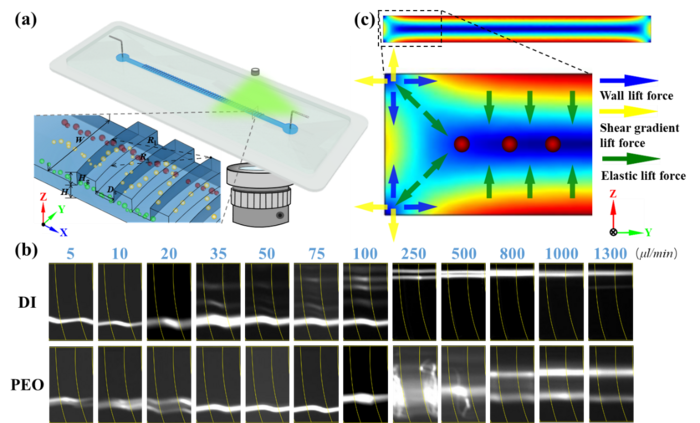
Scientists from Hebei University of Technology and Shenzhen University reported an on-chip viscoelasticity sensor for biological fluids. Image Credit: Sheng Yan, Shenzhen University
A double-layered microfluidic sensor was described in the study, which was published on January 10th, 2023, in the journal Cyborg and Bionic Systems, to identify the ultra-weak viscoelasticity in biological fluids.
Most of human body fluids are non-Newtonian liquids, and the influence of viscoelasticity is often ignored for the sake of simplification of analysis. However, we found that even a very weak change in viscoelasticity can affect the trajectory of micro-particles inside the liquid. Therefore, this viscoelastic effect cannot be ignored in many situations that require elaborate analysis. For this reason, we developed this viscoelastic sensor to detect the weak viscoelastic changes of non-Newtonian liquids.
Sheng Yan, Study Corresponding Author and Assistant Professor, Shenzhen University
Dr. Yan added, “Our microfluidic device is analogy to a “miniature liquid Galton plate”. We “poured” a large amount of microparticles into the channel, recorded the trajectory and distribution of microparticles, and estimate the viscoelasticity of the liquid.”
In non-Newtonian liquids with weak viscoelasticity, experiments have shown that even small changes in viscoelasticity would result in detectable changes in the trajectory and distribution of micro-particles, making it feasible to detect minute viscoelastic changes in non-Newtonian liquids.
It is necessary to first establish the mapping relationship between particle distribution and liquid viscoelasticity to estimate the viscoelasticity of the liquid to be measured. Calibrating the viscoelastic sensor is the procedure used to establish this mapping relationship.
It can be noticed by looking at the trajectory of microparticle movement in various viscoelastic liquids, and Yan emphasized, “Similar to changing the nail on the Galton plate, the movement trajectory of the steel ball will be changed. Changing the viscoelasticity of the liquid will also change the movement trajectory of the microparticles. This shows that it is feasible to measure the viscoelasticity of liquid with this microfluidic chip.”
Lastly, in hopes of estimating the relaxation time of the liquid to be tested, the authors fitted a function to the relaxation times of a variety of non-Newtonian liquids (5–500 ppm PEO). The relaxation time of the liquid to be tested can be readily ascertained with this function.
As an illustration, the relaxation times of 5 ppm and 10 ppm PEO solutions are 0.45 milliseconds and 0.7 milliseconds, respectively. Since the plasma’s viscoelasticity is most similar to that of a 5 ppm PEO solution, the relaxation time is around 0.45 milliseconds.
Yan further stated, “This viscoelasticity sensor has the great potential for early diagnostics of many severe diseases.”
An on-chip viscoelasticity biosensor makes it possible to monitor changes in blood viscoelasticity, which could be a key sign of various inflammatory and vascular diseases.
Journal Reference
Zhao, Q., et al. (2023) An On-Chip Viscoelasticity Sensor for Biological Fluids. Cyborg and Bionic Systems. doi:10.34133/cbsystems.0006.